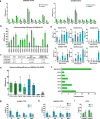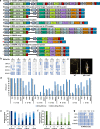Expanding the scope of plant genome engineering with Cas12a orthologs and highly multiplexable editing systems
- PMID: 33782402
- PMCID: PMC8007695
- DOI: 10.1038/s41467-021-22330-w
Expanding the scope of plant genome engineering with Cas12a orthologs and highly multiplexable editing systems
Abstract
CRISPR-Cas12a is a promising genome editing system for targeting AT-rich genomic regions. Comprehensive genome engineering requires simultaneous targeting of multiple genes at defined locations. Here, to expand the targeting scope of Cas12a, we screen nine Cas12a orthologs that have not been demonstrated in plants, and identify six, ErCas12a, Lb5Cas12a, BsCas12a, Mb2Cas12a, TsCas12a and MbCas12a, that possess high editing activity in rice. Among them, Mb2Cas12a stands out with high editing efficiency and tolerance to low temperature. An engineered Mb2Cas12a-RVRR variant enables editing with more relaxed PAM requirements in rice, yielding two times higher genome coverage than the wild type SpCas9. To enable large-scale genome engineering, we compare 12 multiplexed Cas12a systems and identify a potent system that exhibits nearly 100% biallelic editing efficiency with the ability to target as many as 16 sites in rice. This is the highest level of multiplex edits in plants to date using Cas12a. Two compact single transcript unit CRISPR-Cas12a interference systems are also developed for multi-gene repression in rice and Arabidopsis. This study greatly expands the targeting scope of Cas12a for crop genome engineering.
Conflict of interest statement
The authors declare the following competing interests: Yingxiao Z. and Y.Q. are inventors on a U.S. Patent Application (No. 17/090,766) that has been filed on plant genome editing with Cas12a orthologs and multiplexed editing systems reported in this study. All other authors declare no competing interests.
Figures




References
Publication types
MeSH terms
Substances
LinkOut - more resources
Full Text Sources
Other Literature Sources
Research Materials
Miscellaneous

